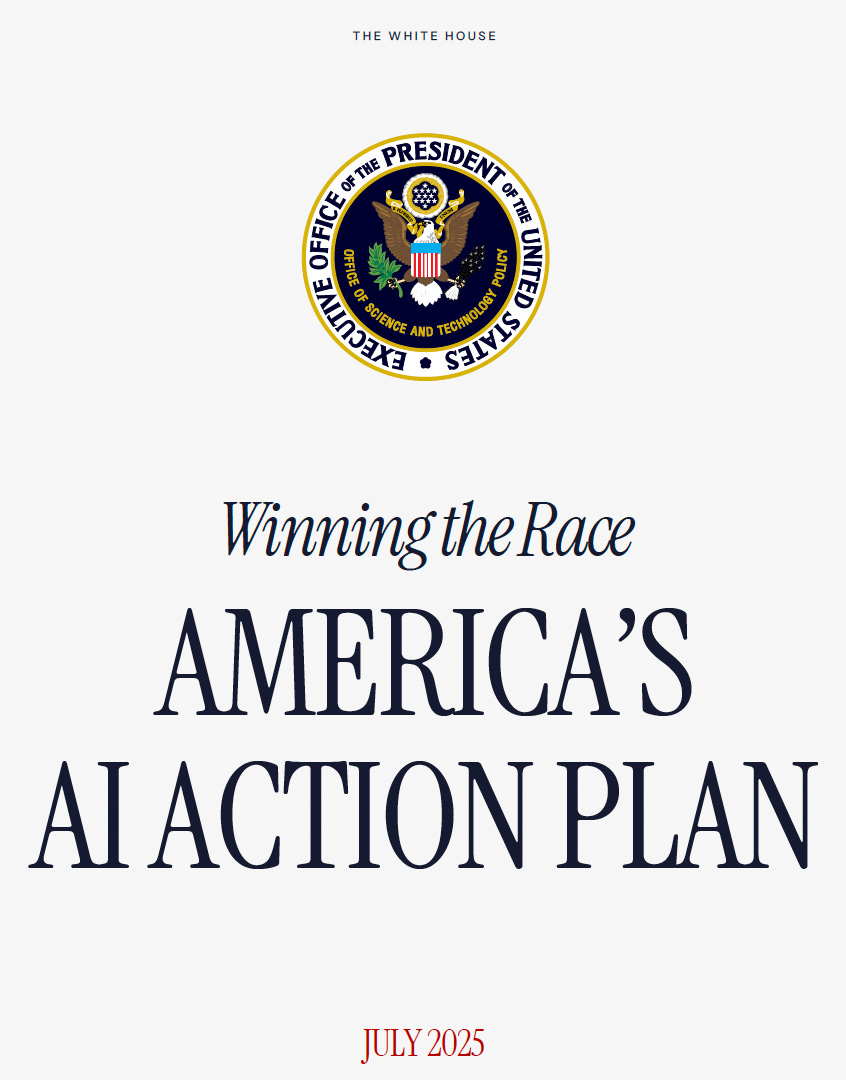America's AI Action Plan: What Washington Demands and How I Would Operationalize It
What you need to know about America's long-term AI stragety (at least until the next adminsitration comes into power).
America’s AI Action Plan is more than another shiny policy memo. It is America’s marching order to slice red tape, overbuild infrastructure, harden national security, and lock allies into a shared rulebook, while rivals scramble to catch up. Below, I spell out what the plan actually says, then add my candid takes to help security and legal leaders convert policy into advantage. If you oversee security, legal, or risk, treat the next pages as your operational playbook.
Cut the Drag Faster Than the Competition
The plan begins with urgency. Agencies must search their rulebooks, highlight anything that slows AI, and either rewrite or erase it within 90 days. That includes decades-old statutes that force companies to print reports no one reads. The Office of Management and Budget will track compliance, and the White House will name and shame laggards in quarterly scorecards.
Plan
Federal money can bypass any state that slaps new, heavy restrictions on AI pilots.
NIST must anchor trust in objective facts. Ideological filters are out.
Open-weight models receive official blessing, and the National Artificial Intelligence Research Resource Pilot (NAIRR) GPU exchange will reduce compute costs.
My Take
Quote the possible loss of grant dollars when state regulators stall your pilot. The leverage is built in.
Design every model answer to cite verifiable data. Auditors can follow the chain, lawyers can sleep.
Treat open checkpoints like third-party code. Scan for poisoned weights, demand signed hashes, and keep a provenance log and AISBOM in your repository.
This phase is not theory. If your compliance team still thinks next year is soon enough, show them the 90 clock and the threat of lost federal funding.
Sandboxes the Plan Will Build and the Guardrails I Would Add
The plan opens up industry sandboxes so that agencies can observe AI projects instead of blocking them at the gate. Each sandbox will carry its own regulator partnership and limited liability, but none will run without baseline controls.
Plan
The Department of Health and Human Services will pilot a clinical sandbox with fast Institutional Review Board paths for hospital data.
The Department of Energy will open grid-adjacent trials that relax Federal Energy Regulatory Commission approvals.
Treasury and the Securities and Exchange Commission will approve narrow AI underwriting pilots overseen by their RegTech offices.
My Take
For healthcare, insist on immutable lineage, real-time error detection, and a twenty-four-hour correction window for any bad recommendation.
For energy, build a drift monitor that can drop generators or storage assets to zero output if metrics hit critical thresholds. Wire that kill switch straight to supervisory control.
For finance, ledger every prompt and every output. Run a fairness audit after each model update, then seal the state so that investigators can rerun decisions byte-for-byte.
Four controls cut across every sector: assign a risk tier, record provenance, monitor live, and serve auditors through an on-demand API. If you standardize those controls, new products move from staging to prod with minimal compliance friction.
Concrete, Electrons, Wafers, and the Labor Nobody Talks About
Data Centers and the Grid
Permitting time kills more AI deals than ransomware kills data. The plan demands new categorical exclusions under the National Environmental Policy Act, trimming site approval from 42 months to under a year. Projects that need cross-agency work will roll into FAST-41, giving them a dedicated navigator. Federal land adjacent to transmission corridors goes on the auction block.
Plan
Stabilize today’s grid assets so older gas turbines remain available for peak load.
Optimize transmission with dynamic routing algorithms that send renewable surplus to load pockets in real time.
Grow new baseload through modular reactors and enhanced geothermal by the end of the decade.
My Take
Form a site selection tiger team next week. Land near cooling water and fiber will disappear first.
Place compact fusion research in the long-range capital budget. Commercial demonstration could arrive in five years.
Insist on a grid readiness score before greenlighting any new compute hall. Downtime kills budgets faster than higher power costs.
Chips and Cold Supply Chains
The CHIPS Act gets a second wind. Grants now trigger only when factories show return on public capital. Social add-ons disappear, which calms investors. Yet the plan highlights a significant labor risk. Carpenters, electricians, HVAC technicians, metal workers and plumbers hold the key to every new factory and data center build.
Plan
The Department of Labor and the Department of Commerce will map shortages by trade and region and fund accelerated apprenticeships.
Employers must publish placement data so the government knows whether programs work.
My Move
Reserve apprentice slots now and lock in retention bonuses. Promise promotions to journeyman status within two years.
Build a corporate trade school in partnership with a community college. Use your own build projects as living classrooms.
Add tradespeople to the succession plan. No senior vice president matters if a broken chiller melts a rack.
Government Secure Data Halls
Defense and intelligence workloads require more than commercial Tier-4. Air-gapped dark cells, sovereign silicon, and intrusion-resistant power feeds become the new normal.
Plan
DoD and the intelligence community will publish the spec in fiscal year 2026.
Contractors must prove a viable design before bidding.
My Move
Mirror those specs today in your blueprint, even for unclassified work. Retrofitting later will cost double.
Offer a proof of concept ahead of the official spec so agencies can test workloads early.
Infrastructure investment is no longer a guessing game. The plan hands out the schedule and the thresholds. Your build is either ready when the government funds arrive, or you join the queue behind competitors who planned earlier.
Open Models, Evaluations, and Red Teams the Plan Funds
Washington commits real dollars to adversarial robustness and interpretability breakthroughs. The money flows to the National Science Foundation, and the Department of Homeland Security. They will open testbeds to any team willing to share findings.
Plan
Launch a grand challenge on adversarial attacks; winning code becomes public domain.
Fund reproducible probes that map how large neuron clusters cooperate.
Ask NIST to publish sector-specific evaluation guides but stop short of enforcement.
Order DHS, in collaboration with CAISI, to stand up an AI-ISAC for model vulnerabilities.
Suggest NIST turn its Guardians of Forensic Evidence deepfake evaluation program into a formal guideline and develop a companion voluntary forensic benchmark.
My Move
Join the grand challenge. Even if you lose, you gain early insight into federal exploit chains.
Make quarterly self-tests against the NIST high-impact tier a release gate. Post a badge on your public trust center when you pass.
Pipe AI-ISAC feeds into your security information and event management system so red teams learn attacker tricks first.
Embed watermarking and tamper-evident logs in every media pipeline before courts dismiss unverified evidence.
Open source is a double-edged sword. The plan sharpens both edges. If you adopt the evaluation cycle now, the next wave of compliance audits looks like a formality instead of an emergency.
Multiply Talent Without Losing Time
People, not GPUs, decide whether AI thrives. The plan clicks on three levers: tax policy, moonshot retraining, and dual-use manufacturing.
Plan
Treasury confirms that AI upskilling qualifies as tax-free education assistance.
The Workforce Research Hub evaluates retraining pilots and demands core numeracy and secure coding before advanced modules.
Title III Defense Production Act money flows to dual-use robotics and drones.
Centers of Excellence allow cleared contractors to rotate into agencies to solve the pay gap.
My Move
Redirect unused office lease spend into employee AI stipends and deduct it.
Build internal progression routes that start with data literacy and end with governance leadership. Skip the hype modules until staff master fundamentals.
Create a sabbatical program. Send rising stars into federal seats. They return with procurement insights that private recruiters cannot match.
Workforce motion needs numbers, not slogans. The plan supplies both. If your talent board lacks electricians, coders, and policy translators, gaps appear in 18 months. Fill them now.
Global Chessboard: Chips, Clauses, and Standards Warfare
The plan is clearly meant to directly address risks from China and Russia. It demands that America keep the lead on wafers. Control model diffusion. Rally allies through standards bodies.
Plan
All advanced chips must verify geographic location and accept remote disable.
Any full-stack AI export must include clauses that block re-export to sanctioned nations and demand privacy pledges from recipients.
Allies who undercut controls face secondary tariffs.
The Department of Commerce will fund travel and staffing so U.S. engineers outnumber authoritarian delegations in ISO, ITU, and IEEE.
CAISI and the intelligence community will chair a permanent red team for frontier models and share results with the Five Eyes alliance first.
Courts will soon require cryptographic provenance for visual evidence, informed by NIST standards.
My Move
Add device attestation checks to every vendor onboarding. Refuse hardware that cannot prove where it lives.
Baseline ITAR-style language in your sales agreements today. Revising late shreds margin.
Diversify fabrication or build domestic second sources before tariffs hit.
Offer expert staff to standards delegations. A plane ticket now can save a product recall later.
Mirror the CAISI red-team test suite so that your public release notes reference national-security depth, not marketing hype.
Store tamper-evident logs for every image and video asset. The courtroom demand will arrive sooner than the tech press expects.
Export controls once sat on the edge of security work. The plan drags them into daily operations. Compliance becomes revenue preservation. Fail here, and shipping stops.
Six Immediate Moves for Any Enterprise
Launch an Action Plan tiger team. Map each directive to revenue, cost, and risk within thirty days, then assign owners.
Update the board scorecard. Track regulatory velocity, megawatts per GPU, and the percentage of AI workloads that self-evidence compliance.
Roll out the sandbox stack across every business unit. Risk tier, provenance ledger, live monitor, and audit API become non-negotiable defaults.
Adopt the NIST evaluation cadence. Self-test quarterly, post badges publicly, and budget fixes before features.
Lock your talent pipeline. Reserve training slots, pre-hire apprentices, and publish an AI career ladder so employees see their future.
Embed export clauses now. Legal teams that wait for final Commerce rules will slow sales. Bake the language today.
These moves cost less than last year’s data lake but shield market position for the next decade.
Key Takeaway
The AI Action Plan delivers a clear split. What Washington orders and where enterprises can surge ahead. The text shreds old rules, accelerates builds, funds security, and arms openness. The chance belongs to leaders who read early and act first.
Call to Action
Book a Complimentary Risk Review with RockCyber. We will thread every plan lever through your strategy before rivals even parse the table of content
Subscribe for more AI security and governance insights with the occasional rant and be sure to share with your friends and colleagues.





